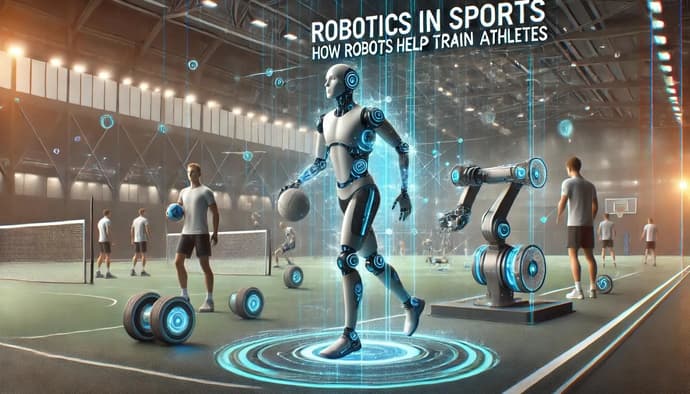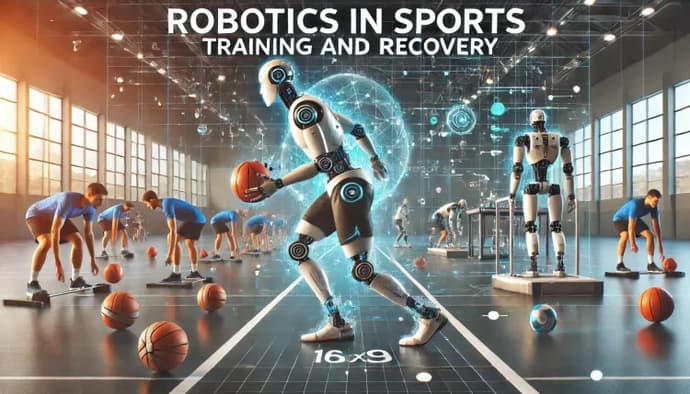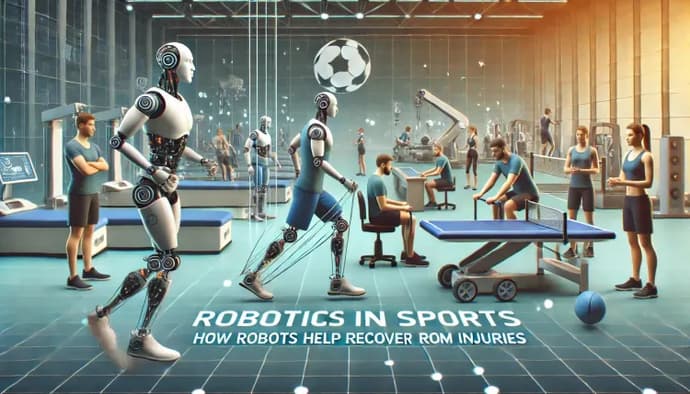
Robotics in Sports: How Robots Help Train Athletes and Recover from Injuries

The most obvious use or benefit of robotics is seen in increasing fan engagement, reducing price, enhancing coverage of sporting events, and many more. Robotics is not new to the sports industry. The integration of sports robotics shoots up the performance of players and also gives them an edge while recovering from an injury. This review explores how these robots are utilized in sports training and rehabilitation.
Robots in Athlete Traning
Precision and Consistency
Robots edge human trainers due to their precision and consistency in outcomes. These machines provide repetitive training drills with similar movements, empowering sports athletes to perfect their techniques. In sports like gymnastics and golf, precision is crucial. A small deviation in form can significantly impact the general performance.
Advanced Simulations
Using robotics, players can be drilled under different conditions. For instance:
- Robotic Pitchers in Baseball: These machines provide a comprehensive training experience here for players by replicating various pitch types, speeds, and trajectories. Batters practice hitting curveballs, fastballs, and sliders with great accuracy.
- Robotic Opponents in Tennis: The Tennibot mimics various playing styles and strategies. With this, players are able to train against a collocation of diverse opponents without a human partner.
Data-Driven Insights
Robots can be equipped with sensors. These sensors collect extensive data on the player’s performance. Data is vital and can be used to analyze and fine-tune techniques. For example, SmartBall tracks the ball’s speed, trajectory, and spin, providing insightful feedback about the player. Coaches, instructors, and players can figure out areas for improvement and also monitor progress over time.
Specific Use Cases in Training
- Boxing and Martial Arts: PunchBot is utilized in training boxers and martial artists. This robot can adjust its movement and speed to match that of the athlete.
- Cycling: the Tacx NEO Smart Trainer is a robotic trainer that provides a realistic riding experience indoors. Difference terrains and levels are simulated, giving the cyclist sufficient training despite the weather conditions.

Robots in Injury Recovery
Rehabilitation robots are automatically operated and are designed to enhance movement in the hand, leg, and ankle of athletes. They are designed to assist players in physical therapy, providing improved physical functioning. Some examples are:
- Lokomat: this exoskeleton assists athletes with lower limb impairments. It offers body weight support, guiding the legs through walking motions.
- ArmeoSpring: This robot assists in upper limb rehabilitation. It supports the arm and gives teh athlete the chance to carry out various exercises to regain mobility and strength.
Customized Recovery Plans
Customized recovery plans can be curated based on the specific needs of the athlete. This would adapt training to the athlete’s progress. For instance:
- MyoCycle Home: This robot assists with adjusting resistance and cycling speed based on muscle activation. Hence providing a curated workout that aids strength and endurance.
Reduced Recovery Time
The recovery process can be accelerated due to the precision and consistency of the robotic therapy. It is necessary to note that the consistency and accurate movement provided by robots produces safer and quicker rehabilitation. Here’s an example:
- AlterG Anti-Gravity Treadmill: Here, air pressure is being used to lift the athlete, which reduces teh impact on joints. It also allows for pain-free walking and running. Hence, cutting short the recovery time for lower limb injuries.
Additional Benefits of Robotics in Rehabilitation
- Real-Time Feedback: athletes and therapists get instant feedback, ensuring that the exercises are carried out appropriately.
- Motivation and Engagement: most rehabilitation robots come with gamification and interactive elements. Athletes stay motivated and engaged during this phase of recovery.
Future of Robotics in Sports
The future of robots in sports is promising, with new technological facets unveiled yearly. These emerging trends include:
- Artificial Intelligence (AI): AI-powered robots enhance training and rehabilitation protocols. They are able to explore complex data and make real-time decisions.
- Wearable Robotics: Robotics exoskeletons are becoming rampant and advanced, also providing support and improving performance during training and recovery.
While exploring how robots are transforming sports, it is necessary to note how technology is also impacting the online gaming sector. Here, Mostbet Casino is a cutting-edge platform that ensures an enhanced gaming experience. The official website provides a variety of top games that have real entertainment value. You also get to experience an excellent payment format and customer service relationship.

Final Remarks
Robotics in sports is revolutionizing and expanding the horizon of what's possible in the sports industry. Athletes can train efficiently and also recover when injured. With accurate training drills, data-driven insights, and advanced simulations, robots help athletes reach their peak performance. During injury, rehabilitation robots provide the necessary support and customized plans, leading to faster and more effective healing. Therefore, the continued integration of robotics in sports and entertainment sets the industry to great heights characterized by enhanced athletic performance and recovery in unprecedented ways. This also paves the way for innovations and improvements in the sports industry.

Elen Stelmakh er en kreativ person som er opptatt av å fremme spillkulturen gjennom artikler og visuell design. Som heltidsansatt EGamersWorld-forfatter og designer for et spillnettsted skaper Elen ikke bare innhold, men tilfører det også energi og kreativitet.
 Mystbloom 2.0 Bundle Detaljer: Liste over alle skins, pris, utgivelsesdato, utseende i spilletMystbloom 2.0 viderefører blomster- / "bloom"-temaet, og beholder de kronbladlignende formene og den sesongbaserte fargepaletten som definerte den første kolleksjonen.
Mystbloom 2.0 Bundle Detaljer: Liste over alle skins, pris, utgivelsesdato, utseende i spilletMystbloom 2.0 viderefører blomster- / "bloom"-temaet, og beholder de kronbladlignende formene og den sesongbaserte fargepaletten som definerte den første kolleksjonen. Oversikt over Dota 2 DreamLeague sesong 27Oppdag alt om DreamLeague sesong 27: tidsplan, format, deltakende lag og premiepotten på 1 000 000 dollar.
Oversikt over Dota 2 DreamLeague sesong 27Oppdag alt om DreamLeague sesong 27: tidsplan, format, deltakende lag og premiepotten på 1 000 000 dollar. Når kommer den nye ARC Raiders-sesongen ut?Cold Snap bringer vinterkart, nye fiender og et oppfrisket Raider Deck til ARC Raiders i desember.
Når kommer den nye ARC Raiders-sesongen ut?Cold Snap bringer vinterkart, nye fiender og et oppfrisket Raider Deck til ARC Raiders i desember. Dreglord: Nightreign Ny Boss GuideDreglord er Nightreigns mest straffende fiende, og krever presise bevegelser, kontrollert aggresjon og en kroppsbygning som er innstilt på press under kaotiske forhold.
Dreglord: Nightreign Ny Boss GuideDreglord er Nightreigns mest straffende fiende, og krever presise bevegelser, kontrollert aggresjon og en kroppsbygning som er innstilt på press under kaotiske forhold.


